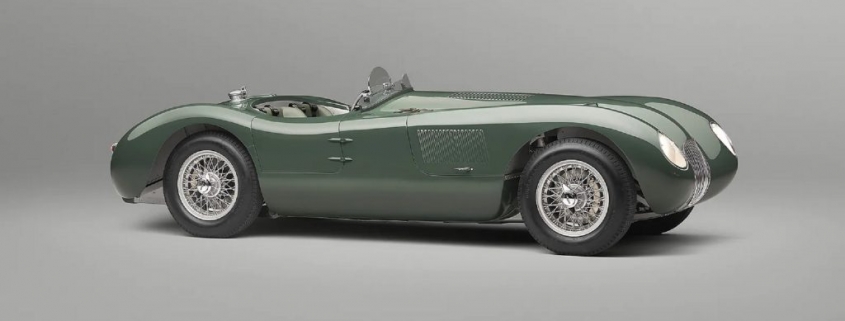1953 Jaguar C-Type Continuation: The Le Mans Legend Lives Again
If you want a classic car with modern build quality, a restomod isn’t the only option. Over the past few years, several automakers have started building ‘continuations’ of their vintage icons. And Jaguar is arguably the most prolific among them. Over the past few years, Jaguar Classic has released continuation D-Types, XKSSes, and several E-Types/XKEs. Now, it’s time for the Jaguar C-Type to be reborn.
Jaguar revives the C-Type as a 70th-anniversary Le Mans win celebration
While we’ve known that Jaguar Classic was resurrecting the C-Type as a continuation car since January, at the time, it was only a render. Now, though, the C-Type Continuation is here in the metal, just in time to celebrate the original car’s 1951 Le Mans win. And that wasn’t just the C-Type’s first win, but also Jaguar’s first Le Mans win, too.
However, despite the 1951 win’s significance, the Jaguar C-Type Continuation isn’t a copy of the 1951 car. And ‘copy’ really is the correct term here, The Drive notes. As with the previous continuation cars, Jaguar used original engineering drawings and a customer car to create the C-Type Continuation. However, this is the first Jaguar Classic continuation reproduced using CAD, making it better built than the original. And that’s not idle speculation: Jaguar itself acknowledges it, Car and Driver notes.
To be fair, the 1951 Jaguar C-Type was advanced in its own right, MotorTrend says. While it started out as an XK120 variant, it eventually ditched that car’s steel chassis for a lightweight tube frame one. And while both cars had aluminum body panels, the C-Type’s are more aerodynamic and aren’t attached to ash-wood frames.
Regardless, the C-Type Continuation isn’t shaped by the 1951 racer. Instead, Jaguar used the 1953 car as the basis for the continuation. And that’s because, not only did it win at Le Mans, too, but it’s arguably even more historically significant.
How close does the C-Type Continuation come to the original 1953 Jaguar C-Type?
However, the 1953 Jaguar C-Type was even more advanced, The Drive notes. For one, while it also has a 3.4-liter inline-six like the 1951 car, it makes 220 hp, rather than 200 hp. And to keep that engine cool, there’s a functional scoop on the hood. Plus, the rear suspension is the upgraded Panhard-rod design. Also, the 1953 C-Type has thinner aluminum bodywork to save weight. How thin? According to Jaguar Classic boss Dan Pink, “’the originals dent if you lean on them,’” Car and Driver says.
But the 1953 Jaguar C-Type’s most significant feature is its Dunlop rear disc brakes. It was the first race car with rear disc brakes at a time when discs were rare, period. They were so cutting-edge that all of the original C-Types sold to private owners use drums, The Drive notes. Hence why Jaguar wants to honor the best version of its race car with the C-Type Continuation.

RELATED: Jaguar’s First XKE Back In Production After 60 Years
And the level of honor is high. Each C-Type Continuation will be hand-built using the same techniques as the original. Jaguar even recreated small details like the spare spark plugs next to the driver’s seat, the spare ignition coil on the chassis rail, and the (accidentally-installed) extra brake-fluid reservoir bracket. And just like the 1953 Jaguar C-Type, the continuation car’s brake rotors are assisted by a gearbox-driven pump.
However, the C-Type Continuation has a few judicious upgrades. There’s a removable roll bar, for one, as well as a new rear cross-member for the safety harnesses that the original lacked. Other safety features include the fire extinguisher and a modern liner for the fuel tank. Plus, the continuation car has a smaller steering wheel, an electric radiator fan, and a modern alternator (with vintage looks). Also, Jaguar uses modern water-based paints for the C-Type Continuation.
How many is Jaguar making?
RELATED: The Aston Martin DB5 Continuation Lets You (Almost) Play Bond for Real
Jaguar made 53 original C-Types in the 1950s, with 43 finding their way into private hands. Originally, the automaker planned on making eight continuation cars. However, it now plans to make 16 examples. Buyers can choose from one of 12 different exterior colors and eight leather options.
Jaguar hasn’t released the C-Type Continuation’s pricing details, but the recreated race car likely comes with a seven-figure price tag, Car and Driver muses. And while it’s eligible for heritage racing events, it’s not street-legal. Though to be fair, even a rough original C-Type costs at least $2.5 million these days, Hagerty says. And some examples go for almost 10 times that much.
But while few will be able to afford one of these resurrected racers, hopefully, those that can will let these cats loose on the track from time to time.
Follow more updates from MotorBiscuit on our Facebook page.
RELATED: Building Your Own Classic Jaguar Could Land You in Big Legal Trouble
The post 1953 Jaguar C-Type Continuation: The Le Mans Legend Lives Again appeared first on MotorBiscuit.







